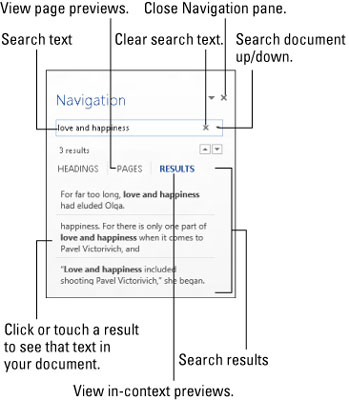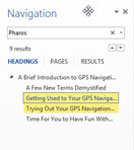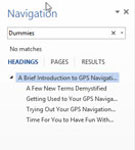Finding text is the domain of the Editing group in Word 2013, found on the far right end of the Home tab on Word's Ribbon interface. The Editing command button group may appear in its full glory, or, when Word’s window is too narrow, simply as an Editing button. When it's a button, you must click the button first to see the palette of commands.
Word can quickly and graphically locate text in your document, from the smallest iota to the world’s longest run-on sentence. It’s handled by the Find command. Abide by these steps:
On the Home tab, click the Find button in the Editing group.

You can also use the keyboard shortcut, Ctrl+F, which is one of the few keyboard shortcuts that makes sense.
Clicking the Find button or pressing Ctrl+F summons the Navigation pane.
Type the text you want to find.

As you type, matching text is highlighted in the document. Depending on which tab is chosen in the Navigation pane, you see a summary of matching results beneath the text box.
Be exact. For example, if you want to find love and happiness, type love and happiness — no period or spaces or quotes. Type only the text you’re looking for.
Click the up or down arrows to page through the search results until you find the exact chunk of text you want.

As you page, the document scrolls to find the next matching bit of text. Text is highlighted in your document, which makes visually searching easier.
Close the Navigation pane when you’re done hunting down text.

When text can’t be found, the Navigation pane tells you that it can’t find the text. It uses the pronoun we, which is a little disturbing.
The Navigation pane may already display text in the Find What box. If so, you can delete the text by pressing the Backspace key.
Do not end the text with a period unless you want to find the period, too.
The Find command can find elements that you can’t readily type, such as the Tab key or Enter key.
If you’re not sure whether the text is typed in uppercase or lowercase letters, use lowercase.
If the text isn’t found and you’re certain that it’s in there, check your spelling. If it’s correct, try searching for a single word rather than two or more words or a sentence.
Word finds text only in the current document (the one you see on the screen). To find text in another document, switch to that document’s window and try searching again.





